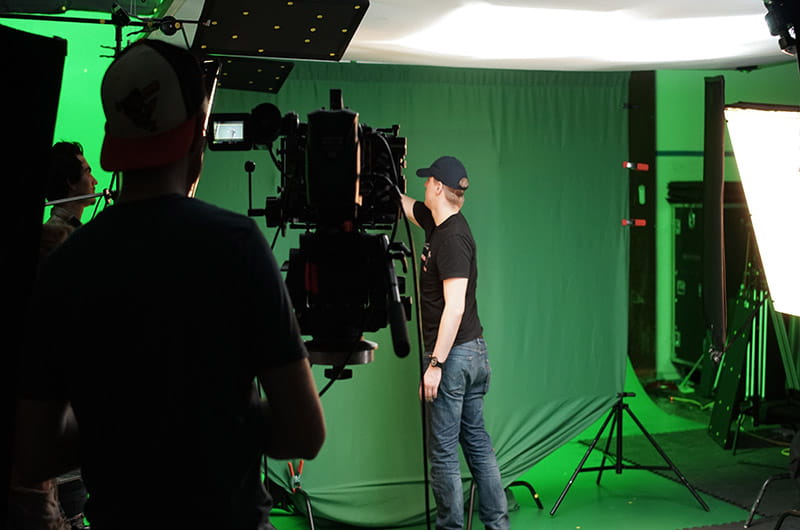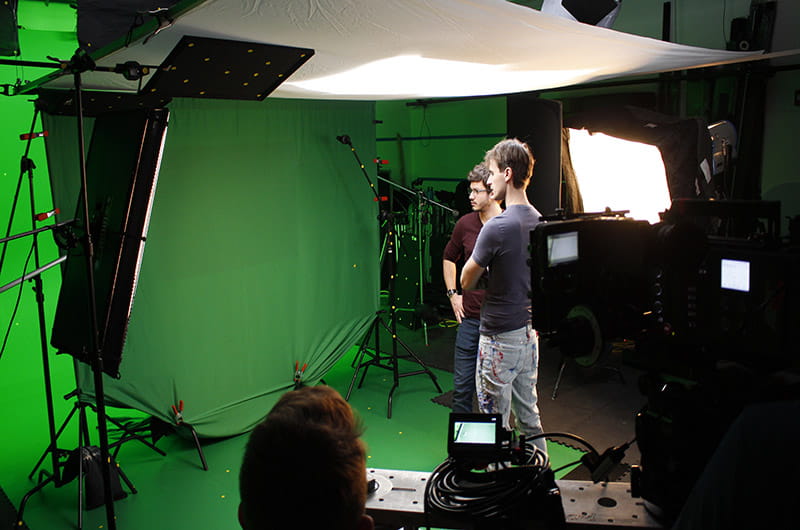‘Tribute:’ Drexel’s First Cross-Department Visual Effects Film

- Through Connections and Community, Drexel Course Helps Launch Computer Lab in Tanzania
- Drexel’s Pearlstein Gallery Offers Spring Exhibitions Centered on the Healing Properties of Art and Creative Works
- The First Exhibition of Contemporary Nepali Artists in the U.S. Debuts in Drexel’s Pearlstein Gallery
- Entrepreneurial Game Studio's App Takes Stanzas to the Streets

Drexel University has a well-known and tested film and video program as part of the Antoinette Westphal College of Media Arts & Design. This program challenges its students, teaching both the theoretical principles of storytelling alongside the technical advances of today's cinematic technologies. But on top of it all, Tristan Alan, a Drexel senior, wanted the unprecedented challenge of bringing visual effects to his senior capstone film, a feat that is often discouraged in many of today's film programs.
Alan came to Drexel with a burning passion for storytelling and a want to channel that passion by becoming a director. In addition to learning how to drive actors, he has devoted his time at Drexel into learning as many parts of the film industry as possible. This included taking classes in cinematography, post-sound, color and even visual effects.
He is one of many ambitious Drexel students who has said “no” to the safer guidelines and restrictions of many film programs, completing several projects that would otherwise fail. This includes shooting with multiple one-takes (films that consist primarily of long shots without cutting), directing child actors and even starting up a Drexel-ran production group that makes films in addition to the normal Drexel curriculum. It is this ambition that has helped him stand out and be one of two students chosen to direct a junior class film and then go on to direct his own senior project.
With an ever-growing interest in post-production, Alan wanted to be able to shoot a full-scale visual effects film, ultimately called “Tribute,” for his senior capstone project.

“For me, it was a personal goal of wanting to learn how to do this because visual effects are huge in the industry and it isn't taught in many programs,” he said. “I want to know something that would make me an asset and if I understand visual effects and animation, then that's something I can really market myself towards.” Understanding the scope of what this would entail from the visual effect courses he did take, Alan decided to reach out to his friends in Westphal's Animation and Visual Effects Program who focus on the art full-time.
This included Eric Hiller, another Drexel senior of the same year [and twin brother of the author of this article] who was similarly taking film classes to further his understanding of the film business while training to enter the visual effects industry. Many film programs in other universities do not teach visual effects. And although Drexel has its own program in visual effects, there seemed to be a disconnect between the film and animation programs.
“Ever since I came to Drexel, I worked to close this gap between our departments,” said Hiller. “I have a strong interest in working in visual effects industry for feature and televised film and wanted a stronger background in working with and between each field. It is through this I met Tristan and had been pushing around the idea of a visual effects capstone project for some time now.”
The main reason there was this gap in the first place was due to any type of collaboration being a tricky business in Drexel's already fast-paced curriculum. In order to make “Tribute” a reality, the team had to jump through several logistical hoops. The first is the integration of a usable workflow between the film and animation majors, since the film has both an entire environment and character constructed in full CGI.

“As this has never been a component of past Drexel film projects, we have had to lay down the groundwork for a usable pipeline - one that sends shots to and from VFX effortlessly without getting lost in the technical details,” Hiller said.
Hiller and his team of compositors, 3D artists and character animators were excited by the challenge of shooting a visual effects film — a task that has not been completed in their digital media department either. The animation program usually focused primarily on game development and animation shorts as opposed to films. But working with Alan, they believed they could be the first to bridge the unprecedented gap between their departments and bring visual effects to the screen on a large scale.
The group created a story centered around an artist and father, Leo, struggling after the loss of his wife. He has lost touch with his passion but also with his daughter. Tasked with creating a portrait of his recently deceased wife, Leo returns to his Mindspace, a fantastic and fully animated visualization of his artistic process. In an evolving canvas of stunning visuals, and with the help of his daughter and her adorable toy (who was brought to life), Leo addresses who he wants to be as an artist and father — and confronts the grief he never dealt with.
The film has over 90 visual effects shots. These range from simply integrating computer-generated images to heighten the emotion on set to compositing the actors into full virtual sets while directly interacting with a cute and furry animated creature. Each of these shots can take anywhere from a few to several dozen man-hours from multiple visual effects artists to integrate properly, on top of the months of work to model, texture, rig, light and render the computer-generated environments and characters present in each shot.

“Everything we do is to further the story that is being told,” said Hiller. “Whether it is the placement of the actors in the virtual Mindspace to the specific emotions evoked by our cute animated creature, our work should always further the narrative, as opposed to just being visual effects for visual effect's sake.”
This collaboration would also reach to the screenwriting, music industry and other programs at Drexel to create one of the larger senior films. This project involves a great mix of many talented people working together on a specific goal. With twenty members on the production crew and another twenty working in the post-production, the film has grown into a statement resurging from Drexel's media arts programs. The students understand that their industries are not separate and isolated departments like on many college campuses. Instead, they are extremely integrated and constantly interacting. This project gives the students an opportunity to mimic the industry and learn this relationship early, giving them a leg up on others who would ignore this possibility.
At the time of this article being written, the film has wrapped shooting and is deep into its post-production schedule. The film will be finally completed by June 1 — a year and a half after the project's conception. The film will be screened at both Drexel's Digital Media and the Film and Video Senior Showcases in early June. After that, the film will be screened in a variety of Philadelphia film festivals and be uploaded to the Internet, potentially being showcased on shortoftheweek.com for its unique niche as a visual effects senior film. Updates will be posted as they come on the film's Facebook and Instagram pages.
“I hope that ‘Tribute’ leads to the film and animation departments working more closely together and spawning more projects in a similar vein,” said Alan. “This project has prepared my team for the pipeline of big-budget films and I hope that this knowledge is something that will be passed down to future Drexel students.”
By Jay Hiller, a senior animation and visual effects major and video production minor in the Westphal College of Media Arts & Design and a Pennoni Honors College student, as part of the winter 2018 “Writing for Drexel Publication” Pennoni Honors College course.
Drexel News is produced by
University Marketing and Communications.